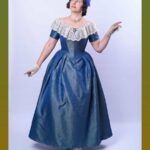Embark on a captivating journey through the annals of Irish fashion in [Unveiling the History of Irish Clothing: A Journey Through Stylish Heritage]. Discover the rich tapestry of traditional Gaelic attire, from the iconic kilts and intricate sweaters to the elegant shawls and bonnets. Delve into the stories behind each garment, exploring their cultural significance and the influences that shaped their unique designs.
Key Takeaways:
- Medieval and Renaissance Irish wore a large linen shirt called the leine, often dyed yellow.
- English law and cultural pressure in the 18th and 19th centuries discouraged traditional Irish dress.
- Traditional Irish clothing includes the leine, Aran sweater, tweed clothing, and traveler attire.
History of Irish Clothing: A Journey Through Stylish Heritage
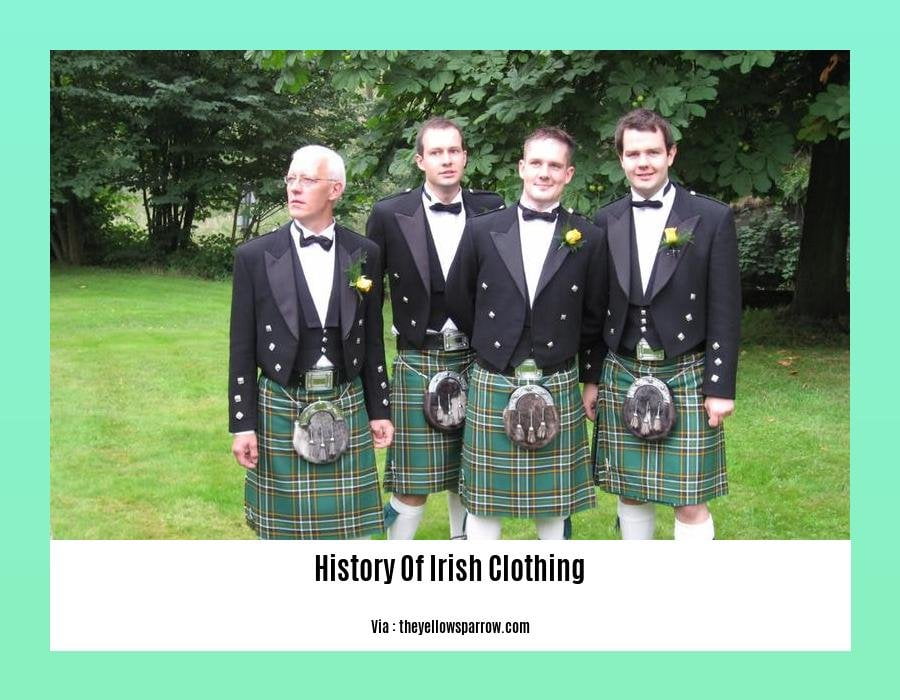
Unraveling the tapestry of Irish clothing history, we embark on a captivating journey that echoes with cultural identity, artistic flair, and the spirit of perseverance. From ancient origins to contemporary creations, Irish fashion has stood as a testament to the nation’s rich heritage, showcasing a vibrant weave of tradition, innovation, and global influences.
Ancient Attire: Rooted in Tradition
In the annals of Irish history, clothing played a pivotal role. The leine, a voluminous shirt crafted from linen and often dyed in vibrant hues, was a cornerstone of the ancient Irish wardrobe. This loose-fitting garment, adorned with intricate embellishments, symbolized both comfort and cultural pride. Wool, a natural fiber abundant in the Irish landscape, was skillfully transformed into warm and durable garments, providing protection against the elements.
Medieval Transformations: Blending Cultures
As Ireland navigated the medieval era, its clothing evolved under the influence of diverse cultural currents. The arrival of the Normans brought forth new styles and techniques, leading to a fusion of Irish and continental aesthetics. Tailoring became more refined, and garments began to reflect a growing sense of individuality and status.
18th and 19th Centuries: Challenges and Resilience
The 18th and 19th centuries presented both challenges and opportunities for Irish fashion. As English influence grew, traditional Irish clothing faced restrictions and suppression. Despite these obstacles, the spirit of Irish creativity found expression in subtle ways, with intricate weaving patterns and vibrant colors persisting as symbols of cultural resilience.
Modern Revival: A Resurgence of Heritage
The 20th century witnessed a resurgence of interest in Irish cultural identity, leading to a renewed appreciation for traditional clothing. Designers and artisans delved into the rich archives of Irish history, reimagining classic styles with a contemporary twist. The Aran sweater, with its iconic cable-knit patterns, emerged as a global symbol of Irish heritage, while tweed, a durable and versatile fabric, became synonymous with Irish fashion.
Contemporary Expressions: A Tapestry of Influences
In the 21st century, Irish fashion continues to evolve, drawing inspiration from a diverse range of sources. From the vibrant hues and bold patterns of traditional Irish knitwear to the sleek lines and modern silhouettes of contemporary design, Irish clothing has become a vibrant reflection of a nation that embraces its past while confidently striding into the future.
Celebrating the Weave of History
Throughout the history of Irish clothing, we witness a remarkable tapestry of cultural influences, artistic innovation, and enduring traditions. From the humble leine to the globally recognized Aran sweater, Irish fashion has captured the spirit of a nation, showcasing its resilience, creativity, and unwavering connection to its heritage.
For an in-depth look into the intricate history of Irish jewelry, I highly recommend you to visit our page on history of Irish jewelry and explore the rich traditions and craftsmanship that have shaped this beloved art form. If you’re interested in learning about the evolution of Irish step dance, don’t miss our comprehensive article on history of Irish step dance that delves into the origins, influences, and iconic figures that have shaped this captivating dance form.
Traditional Irish Clothing Female
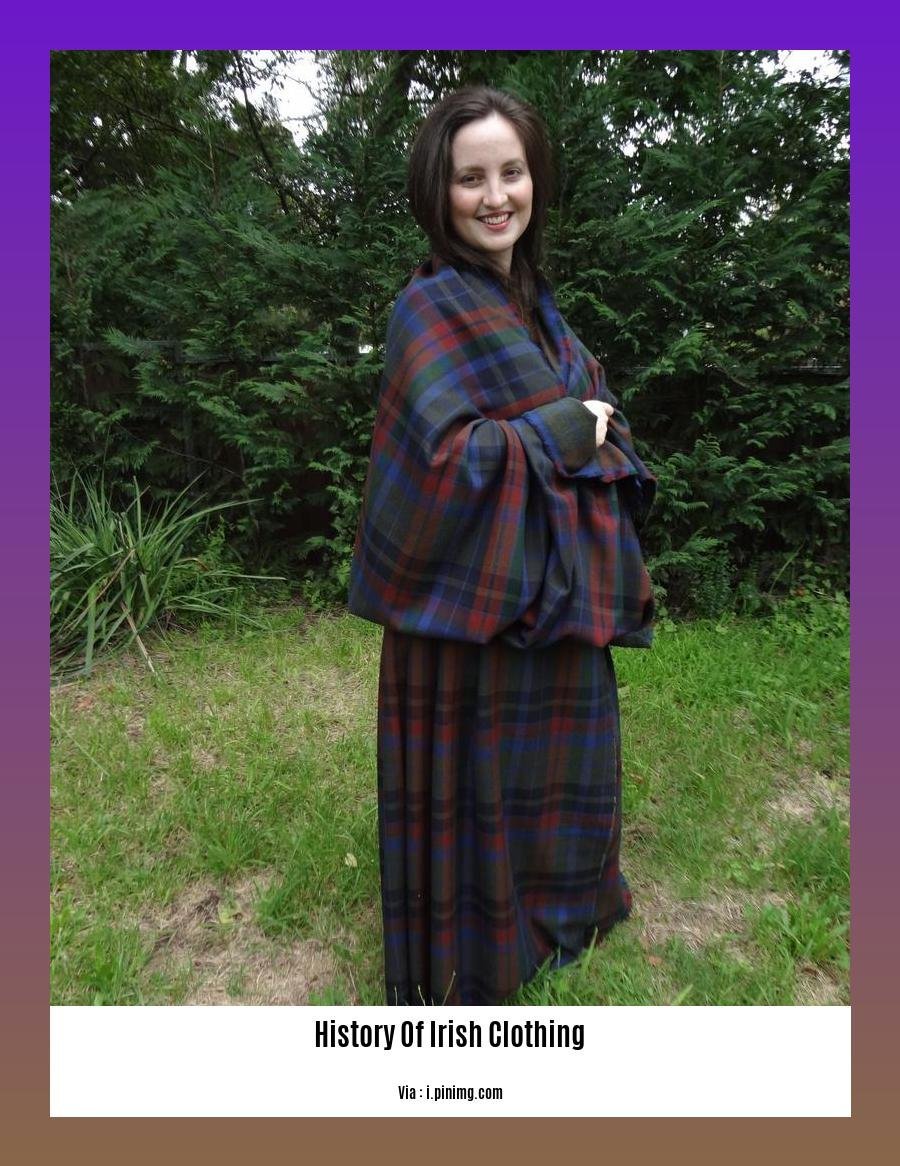
Key Takeaways:
- The early Traditional Irish Clothing Female mirrored English fashion trends, including skirts, dresses, and shawls.
- Essential pieces like the mantle, leine, and inar showcased Irish craftsmanship and style.
- Documentation of early Irish clothing is limited, especially before the 12th century.
- Clothing served as a status symbol, with the wealthy adorning elaborate mantles.
- Irish fashion harmoniously blended indigenous styles with influences from neighboring cultures.
Fashion has long been a reflection of culture, identity, and societal influences. In Ireland, clothing holds a rich history that speaks to the country’s past, its people’s pride, and the evolution of Irish style. While early records are scarce, the available evidence paints a vivid picture of the distinct attire worn by Irish women throughout the centuries.
Early Influences: A Blend of Styles
In the early 1800s, Irish clothing mirrored English fashion, reflecting the influence of the dominant culture. Women donned skirts or dresses, often paired with aprons and Galway shawls, while blouses completed their ensembles. These garments were crafted from readily available materials like linen and wool, showcasing the practicality and resourcefulness of Irish women.
Notable Traditional Garments
The mantle, a coat made of wool cloth, emerged as a popular garment in the 13th century. Its versatility made it suitable for both everyday wear and special occasions. The leine, a linen shirt, was a staple for both men and women, providing comfort and coverage. The inar, a pleated jacket with split sleeves, added a touch of elegance to traditional Irish attire.
Preserving a Cultural Legacy
Despite the passage of time, the legacy of traditional Irish clothing remains alive through various initiatives aimed at preserving and showcasing this cultural heritage. Museums, cultural organizations, and fashion enthusiasts play a crucial role in safeguarding these garments, ensuring they continue to tell the story of Ireland’s rich past.
Symbolism and Status
In Irish society, clothing served as a visual representation of wealth and status. The wealthy adorned themselves with elaborate mantles and other garments, demonstrating their social standing and affluence. This practice underscored the importance of clothing as a means of expressing one’s place in society.
Cultural Exchange and Evolution
Irish fashion has undergone a remarkable journey, influenced by neighboring cultures like England and Scotland. Over time, these influences blended harmoniously with indigenous styles, creating a unique and diverse fashion landscape. This cultural exchange enriched Irish clothing, adding new elements and techniques that helped shape its distinctive identity.
References:
What Do People Wear in Ireland? – Reference.com
What Constitutes Irish Traditional Dress? – Shamrock Gift
FAQ
Q1: What was the traditional clothing of the ancient Gaels like?
A1: The ancient Gaels wore a variety of clothing items, including the leine, a long linen shirt; the brat, a woolen cloak; and the truis, a pair of trousers. These garments were often decorated with intricate Celtic designs.
Q2: What were the differences between men’s and women’s traditional Irish clothing?
A2: Men’s traditional Irish clothing typically consisted of a leine, brat, and truis, while women’s clothing included a leine, brat, and crios, a type of sash. Women’s clothing was often more brightly colored and elaborately decorated than men’s clothing.
Q3: How did traditional Irish clothing change over time?
A3: Traditional Irish clothing underwent a number of changes over time. In the early centuries, it was heavily influenced by Celtic culture. However, as Ireland came into contact with other cultures, such as the Vikings and the Normans, its clothing began to reflect these influences as well. By the 19th century, traditional Irish clothing had largely been replaced by more modern styles of dress.
Q4: What are some examples of traditional Irish clothing that are still worn today?
A4: Some examples of traditional Irish clothing that are still worn today include the Aran sweater, the tweed suit, and the Galway shawl. These items of clothing are often worn on special occasions, such as weddings and festivals.
Q5: Where can I learn more about traditional Irish clothing?
A5: There are a number of places where you can learn more about traditional Irish clothing. The National Museum of Ireland has a collection of traditional Irish clothing and textiles. There are also a number of books and websites that discuss the history of Irish clothing.
- Star Ring Trends: Etsy vs Amazon - March 28, 2025
- Boost Pollinator Habitats: Baby Blue Eyes Sustainable Farming Guide - March 28, 2025
- Protect Big Black Bears: Effective Conservation Strategies - March 28, 2025
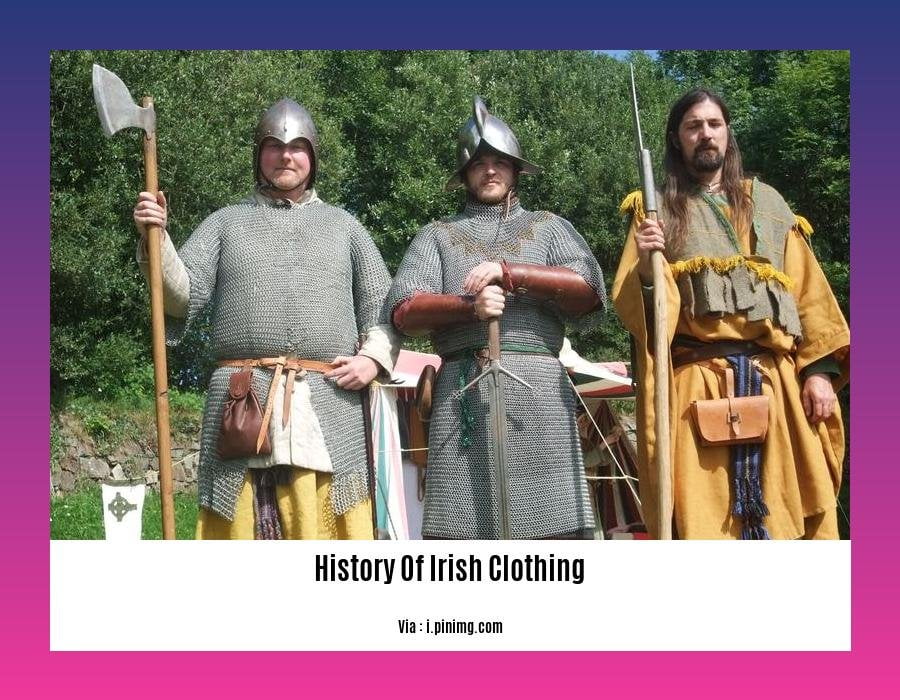
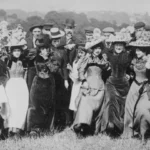
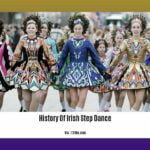

![A Stitch in Time: Exploring the Evolution of Clothing in India Through the Millennia [clothing in india history] clothing-in-india-history_2](https://www.lolaapp.com/wp-content/uploads/2023/12/clothing-in-india-history_2-150x150.jpg)
